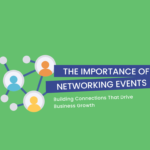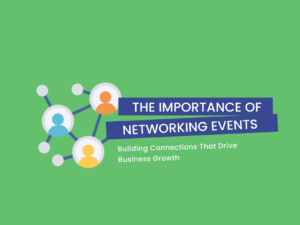
Welcome back to the CorpCrew blog, your trusted source for all things event planning! In corporate events, success isn’t just about putting on a great show—it’s about demonstrating measurable returns on investment (ROI). Ever wondered how to measure your ROI, what key metrics you need, and what analytics you need to evaluate your event? Today, we’re diving deep into the world of event success metrics.
Determining Key Performance Indicators (KPIs):
Before diving into the event data sea, define your Key Performance Indicators (KPIs). KPIs are the guiding North Star for your event. Do you want to increase your brand awareness? Generate revenue? Build a community? The KPIs you define upfront will then inform the creation of your analytics strategy to track what matters.
Quantitative Metrics:
These metrics provide tangible, numerical data to assess various aspects of your event.
Attendance and participation rates:
It’s not enough to record and track headcounts; you must also track attendance and participation rates. Are you getting a good sense of how many people are interested in sessions, networking, and other activities, and if so, how many are engaged? The higher the attendance and participation rates, the more impact an event experience makes.
Revenue and Financial Metrics:
Revenue can be tricky, especially because it includes more than ticket sales. For more accurate benchmarking across events, look at sponsorships, merchandise sales, and post-event deals to get a comprehensive view of your event’s financial performance.
Social Media Metrics:
In an age of digital media, social networking is a rich bed of real-time feedback and interaction. Key metrics relating to impressions, reach, engagement (likes, comments, shares), and hashtags provide a great way to track your event’s presence and brand visibility online.
Website and App Analytics:
Review your event website and app data to understand user behaviour, traffic sources, and content engagement. Look for metrics like page views, session length, click-through rates, and downloads to improve user experience and content strategy.
Post-Event Surveys and Feedback:
Nothing is more valuable to an event planner than their attendees’ direct feedback. Post-event surveys offer a qualitative approach to measuring satisfaction, rating the event, identifying improvement areas, and understanding your attendees’ overall experience. Include open-ended questions to get more in-depth responses from your respondents.
Qualitative Metrics for Event Success:
Qualitative metrics will provide a nuanced picture of how events make people feel, going beyond numbers to capture attendee sentiments.
Attendee Satisfaction Surveys:
Attendees are also the best source for understanding their experience. Surveys can include a standard set of rating scales and open-ended questions to provide detailed descriptions of participants’ experiences, including memorable moments, specific pieces of material that stood out, or relationships with others that were formed. Attendee surveys should also solicit ratings of speakers and presenters.
‘Thank You’ Letters and Customer Testimonials:
Collect ‘thank you’ letters and written or video testimonials from attendees, speakers, and sponsors to show the impact of your organisation and event personally – and how it contributed to a larger participant, member, partner, and stakeholder value. Qualitative anecdotes can be coupled with quantitative examples of actualised outcomes.
Cultural and Inclusivity Metrics:
Events that encourage diversity create a sense of belonging. Monitor metrics on attendees’ diversity, representation among speakers and panellists, and measures of inclusion to show that your event is diverse and inclusive.
Post-Event Interviews:
Set up a series of one-on-one interviews with all stakeholders, attendees, speakers, event partners, and sponsors and request feedback, areas of challenge, and ideas for future events.
Impact on community:
Measure the impact of your event on the surrounding community (e.g., partnerships forged, knowledge disseminated, and social causes supported), whether through volunteer efforts, charitable donations, and other forms of community engagement to demonstrate the positive impact of your event outside the confines of your venue.
Using qualitative and quantitative scores in the different categories gives you a better idea of what worked and what didn’t, what people appreciated, and what they wanted more of. This will help you improve future events.
Measuring Social Media Engagement:
The assessment of social media engagement is a complex exercise that takes into account findings across the key stages of the event lifecycle:
Pre-event Buzz Analysis:
Before the event begins, it’s important to assess the mood and buzz generated by your audience. Through mentions, hashtags, and discussions of the event theme or topic, you can identify the level of interest in your event before it.
Audience Reach and Impressions:
These KPIs tell you who has seen and engaged with your content. By analysing the number of views, shares, and impressions on social channels, you can quantify the potential audience exposed to your event.
Event Engagement Metrics:
While the event is happening, a great way to monitor its success is to measure engagement metrics while the event is in play. The likes, comments, shares, and views of posts, photos, and videos on your social network where the event occurs. If engagement is high, that is a good sign that your audience is interested in the event.
Platform Analytics:
Every social media platform has its own set of analytics where you can measure performance metrics specific to that platform. You can use these analytics to look deeper into your audience demographics, content performance, and engagement trends on platforms like Twitter, Facebook, LinkedIn and Instagram.
Live-Tweeting and Real-Time Updates:
Live-tweeting at your event and providing real-time updates can greatly increase the engagement and commentary of your audience, both in the room and online. Reading responses to your live-tweeted content and updates allows you to adjust the messaging to what attendees and online participants respond to.
Post-Event Engagement Analysis:
Your event isn’t ongoing when the curtains close or the last attendee heads home. Analysing shares, comments, and mentions about your event after it wraps up can help you better measure its legacy and discover ways to continue conversations with attendees and online followers.
Assessment of Influencer Engagement:
The involvement of specific influencers is a tool for extending the event’s reach and building engagement. Evaluating influencers’ engagement with your event (for example, reach, impressions, and audience engagement) helps measure the effectiveness of influencer campaigns in increasing awareness and attendance.
Social Listening & Sentiment Analysis:
Use comprehensive social media listening tools to track and analyse chatter about your event. This can give you a feel for your audience’s thoughts and opinions, including important trends and emerging topics. Adding sentiment analysis tools can offer more qualitative insights into how your event is perceived.
Event Conversion Rates:
Finally, event conversion rates measure the impact of your event on endorsed actions or conversions. Whether it’s website visits, registrations, or sales, social media engagement conversion will determine how you measure your event’s ROI.
From these, you can calculate key metrics to evaluate the impact of your social media engagement strategies at different stages of the event life cycle and use analytics tools to dissect the results.
Assessing Collaborative Success:
Ideally, many data points are involved in determining how well an event sponsorship or partnership achieved its goals post-event. Aside from just how many people attended? We’re talking about the real effect of these collaborations on your event, influencing how well it met its objectives.
Attendee Engagement Activity:
If sponsors have booths or exhibit spaces, track foot traffic and attendees’ engagement with those spaces to understand whether these physical interactions were effective. Track whether sponsors find the exclusive opportunities you give them—like speaking slots, workshops, or networking events—worth the value of their sponsorship and worth their time.
Lead Generation and Business Opportunities:
One key intended outcome of event sponsorships and partnerships is generating leads and creating business opportunities for event sponsors and partners. Generating many leads is not enough; the quality of leads is also important. Lead-generation metrics can be used to assess whether sponsorships and collaborations have created valuable leads and potential business deals.
Post-Event Surveys and Feedback:
Feedback from attendees gives you amazing insights into how sponsorships and partnerships are affecting the attendee experience. Sending surveys out after the event gives you insight into how attendees perceived their event, how satisfied they were, and how partnerships and sponsorships impacted their experience. This feedback loop helps you to hone your partner strategy for the next event.
Media Coverage and Publicity:
The increased exposure gained through media coverage and publicity is a tangible result of good event collaboration. Watch for press listings and media coverage in news articles and other outlets to measure the impact of your collaborations beyond the venue. Good media coverage amplifies your message and reinforces your collaborations’ worth.
Social Media Engagement Metrics:
Event sponsorships and partnerships work best in our connected world because social media amplifies incredibly. Monitor your social media engagement numbers, including likes, shares, comments, and any mentions of the partner’s hashtag, to see how many people are talking about your collaborations online. A strong social media presence not only reaches more people but also amplifies the reach of your partnerships in the digital space.
By examining these important metrics across various dimensions, you can better understand your collaborative success through event sponsorships and partnerships.
Conclusion:
Measuring every success – large and small – is critical to improving what you do well and learning from your failures. As event organisers, it is our responsibility to measure event ROI. By having clear and measurable goals, collecting and assessing data, and using technology, we can leverage our events to their fullest potential and deliver returns for our brands, companies, and clients.
At CorpCrew, we guide you through the essentials of event success—the subtle and sometimes abstract factors that should guide your evaluation. Ready to take your event planning to the next level? Contact us today to learn more about our comprehensive event planning services and how we can help you maximise the ROI of your next event.







No comment yet, add your voice below!